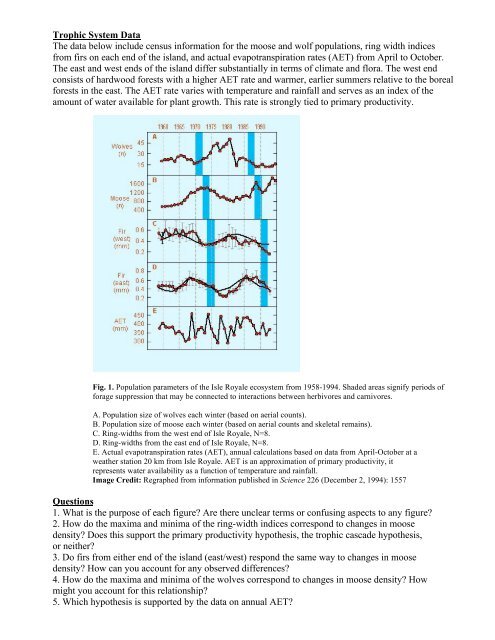The Wolf, Moose, and Fir Tree: Who Controls Whom on Isle Royale ...
The Wolf, Moose, and Fir Tree: Who Controls Whom on Isle Royale ...
The Wolf, Moose, and Fir Tree: Who Controls Whom on Isle Royale ...
Create successful ePaper yourself
Turn your PDF publications into a flip-book with our unique Google optimized e-Paper software.
Trophic System Data<br />
<str<strong>on</strong>g>The</str<strong>on</strong>g> data below include census informati<strong>on</strong> for the moose <str<strong>on</strong>g>and</str<strong>on</strong>g> wolf populati<strong>on</strong>s, ring width indices<br />
from firs <strong>on</strong> each end of the isl<str<strong>on</strong>g>and</str<strong>on</strong>g>, <str<strong>on</strong>g>and</str<strong>on</strong>g> actual evapotranspirati<strong>on</strong> rates (AET) from April to October.<br />
<str<strong>on</strong>g>The</str<strong>on</strong>g> east <str<strong>on</strong>g>and</str<strong>on</strong>g> west ends of the isl<str<strong>on</strong>g>and</str<strong>on</strong>g> differ substantially in terms of climate <str<strong>on</strong>g>and</str<strong>on</strong>g> flora. <str<strong>on</strong>g>The</str<strong>on</strong>g> west end<br />
c<strong>on</strong>sists of hardwood forests with a higher AET rate <str<strong>on</strong>g>and</str<strong>on</strong>g> warmer, earlier summers relative to the boreal<br />
forests in the east. <str<strong>on</strong>g>The</str<strong>on</strong>g> AET rate varies with temperature <str<strong>on</strong>g>and</str<strong>on</strong>g> rainfall <str<strong>on</strong>g>and</str<strong>on</strong>g> serves as an index of the<br />
amount of water available for plant growth. This rate is str<strong>on</strong>gly tied to primary productivity.<br />
Fig. 1. Populati<strong>on</strong> parameters of the <strong>Isle</strong> <strong>Royale</strong> ecosystem from 1958-1994. Shaded areas signify periods of<br />
forage suppressi<strong>on</strong> that may be c<strong>on</strong>nected to interacti<strong>on</strong>s between herbivores <str<strong>on</strong>g>and</str<strong>on</strong>g> carnivores.<br />
A. Populati<strong>on</strong> size of wolves each winter (based <strong>on</strong> aerial counts).<br />
B. Populati<strong>on</strong> size of moose each winter (based <strong>on</strong> aerial counts <str<strong>on</strong>g>and</str<strong>on</strong>g> skeletal remains).<br />
C. Ring-widths from the west end of <strong>Isle</strong> <strong>Royale</strong>, N=8.<br />
D. Ring-widths from the east end of <strong>Isle</strong> <strong>Royale</strong>, N=8.<br />
E. Actual evapotranspirati<strong>on</strong> rates (AET), annual calculati<strong>on</strong>s based <strong>on</strong> data from April-October at a<br />
weather stati<strong>on</strong> 20 km from <strong>Isle</strong> <strong>Royale</strong>. AET is an approximati<strong>on</strong> of primary productivity, it<br />
represents water availability as a functi<strong>on</strong> of temperature <str<strong>on</strong>g>and</str<strong>on</strong>g> rainfall.<br />
Image Credit: Regraphed from informati<strong>on</strong> published in Science 226 (December 2, 1994): 1557<br />
Questi<strong>on</strong>s<br />
1. What is the purpose of each figure? Are there unclear terms or c<strong>on</strong>fusing aspects to any figure?<br />
2. How do the maxima <str<strong>on</strong>g>and</str<strong>on</strong>g> minima of the ring-width indices corresp<strong>on</strong>d to changes in moose<br />
density? Does this support the primary productivity hypothesis, the trophic cascade hypothesis,<br />
or neither?<br />
3. Do firs from either end of the isl<str<strong>on</strong>g>and</str<strong>on</strong>g> (east/west) resp<strong>on</strong>d the same way to changes in moose<br />
density? How can you account for any observed differences?<br />
4. How do the maxima <str<strong>on</strong>g>and</str<strong>on</strong>g> minima of the wolves corresp<strong>on</strong>d to changes in moose density? How<br />
might you account for this relati<strong>on</strong>ship?<br />
5. Which hypothesis is supported by the data <strong>on</strong> annual AET?


